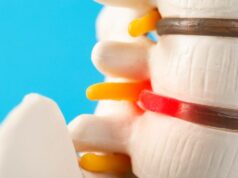
Stayble’s new analyses of phase IIb study strengthen disc herniation project
Earlier this autumn, Stayble Therapeutics announced that the drug candidate STA363 had not met the primary endpoint in the phase IIb study in patients with degenerative disc disease. Now, however, additional analyses from the study are presented that may prove to have a bearing on the company’s other project regarding herniated discs. BioStock reached out to CEO Andreas Gerward to find out more.
Stayble Therapeutics is developing the injection treatment STA363 for chronic back pain. This year, the company have had two ongoing clinical projects, one for the treatment of degenerative disc disease and one for chronic disc herniation. A clinical phase Ib study with STA363 is currently underway in patients with herniated discs, and earlier this autumn the company completed a phase IIb study in patients with degenerative disc disease.
To the company’s great disappointment, the phase II study did not meet the primary endpoint of showing statistically significant pain reduction in patients with degenerative disc disease.
Statistically significant reduction in disc height
Since the release of the topline results, Stayble Therapeutics has conducted further analyses of the data. Last week, the company announced that the analyses provides significant support for their herniated disc project.
MRI scans in the study dose-dependent reduction in disc height and intensity, which is a measure of the water content in the disc. In the highest dose group, these changes were statistically significant compared to placebo (disc height: p=0.0001; intensity: p=0.0635). The fact that the results are statistically significant means that there is a low probability that the observations are a coincidence.
A statistically significant reduction in disc height was also observed in the lower dose group. However, in the company’s phase Ib study, the higher dose is used, which is considered optimal as it provides a greater effect than the lower one.
Reduction of disc volume can provide pain reduction
The company’s goal with the STA363 treatment is to reduce the volume of the disc and thus reduce the pressure of the herniated disc on nerve roots, thereby reducing pain. The decrease in the height of the disc is a sign that the treatment is producing the desired volume-reducing effect. Reducing the intensity is also a prerequisite for a reduction in volume and pressure in the disc.
CEO Andreas Gerward explains
Stayble Therapeutics will continue to analyse phase IIb data and will update the market as soon as these analyses are completed. In addition, the company looks forward to presenting results from the ongoing phase Ib study in patients with herniated discs.

BioStock reached out to the company’s CEO Andreas Gerward to gain a deeper understanding of the latest analysis from the phase IIb study with STA363.
What are the key details of the latest analysis of the phase IIb study that supports your herniated disc project?
– In the phase Ib study on degenerative disc disease that was completed a few years ago, we saw tendencies in reduction of disc height and intensity. However, there were far too few patients in that study for any firm conclusions to be drawn. We now show that there is not only a proven effect on disc height and intensity, but also that it is clearly dose-dependent. Decrease in disc height, and to some extent intensity, is a validated marker for disc volume reduction, and the relationship between disc volume reduction and herniated disc shrinkage has been shown in several published studies.
– We are very pleased that we chose the higher dose for the herniated disc study because it was clearly better than the lower one. It should not be forgotten that we now have a large number of patients who have had STA363 injected into one or two discs and the safety and tolerability have proven to be good.
What does it mean that something is statistically significant in probability theory?
– It means that the result has a low probability of having occurred by chance.
– If we look at disc height, we have a p-value (measure for the level of significance) of p=0.0001. This means that there is a 0.01 percent probability (i.e. 1 in 10,000) that the difference we see in disc height between the highest dose and placebo is due to chance.
What is the scientific support for your therapeutic principle of reducing the volume of the disc to achieve pain reduction in herniated discs?
– The best example of this principle comes from a treatment that was widely used in the United States until the beginning of the millennium. It disappeared from the market for reasons unrelated to a lack of efficacy, and many doctors expressed their dissatisfaction with this. An enzyme was injected that, similar to what we believe STA363 does, breaks down the molecules that attract water into the disc.
– As a result, the water content and volume decreased, the hernia shrank and the patients’ symptoms disappeared or decreased sharply. Thousands of patients were treated with very good results. A minority respond poorly to this treatment principle and got calcified hernias. The only way to get rid of such hernias is to surgically remove them.
Now, 2023 is coming to an end. How would you sum up the year for Stayble Therapeutics?
– An incredibly exciting year with important progress but also a major disappointment linked to the negative phase IIb results.
What are your expectations for 2024?
– We are focusing on our project in herniated discs and look forward to presenting results from the study in 2024.
The content of BioStock’s news and analyses is independent but the work of BioStock is to a certain degree financed by life science companies. The above article concerns a company from which BioStock has received financing.

